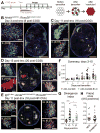Visualizing antibody affinity maturation in germinal centers
- PMID: 26912368
- PMCID: PMC4938154
- DOI: 10.1126/science.aad3439
Visualizing antibody affinity maturation in germinal centers
Abstract
Antibodies somatically mutate to attain high affinity in germinal centers (GCs). There, competition between B cell clones and among somatic mutants of each clone drives an increase in average affinity across the population. The extent to which higher-affinity cells eliminating competitors restricts clonal diversity is unknown. By combining multiphoton microscopy and sequencing, we show that tens to hundreds of distinct B cell clones seed each GC and that GCs lose clonal diversity at widely disparate rates. Furthermore, efficient affinity maturation can occur in the absence of homogenizing selection, ensuring that many clones can mature in parallel within the same GC. Our findings have implications for development of vaccines in which antibodies with nonimmunodominant specificities must be elicited, as is the case for HIV-1 and influenza.
Copyright © 2016, American Association for the Advancement of Science.
Figures





References
-
- Eisen HN, Siskind GW. Variations in Affinities of Antibodies During the Immune Response. Biochemistry. 1964 Jul;3:996. - PubMed
-
- Eisen HN. Affinity enhancement of antibodies: how low-affinity antibodies produced early in immune responses are followed by high-affinity antibodies later and in memory B-cell responses. Cancer Immunol Res. 2014 May;2:381. - PubMed
-
- MacLennan IC. Germinal centers. Annu Rev Immunol. 1994;12:117. - PubMed
-
- Rajewsky K. Clonal selection and learning in the antibody system. Nature. 1996 Jun 27;381:751. - PubMed
Publication types
MeSH terms
Substances
Grants and funding
LinkOut - more resources
Full Text Sources
Other Literature Sources
Molecular Biology Databases
Miscellaneous

